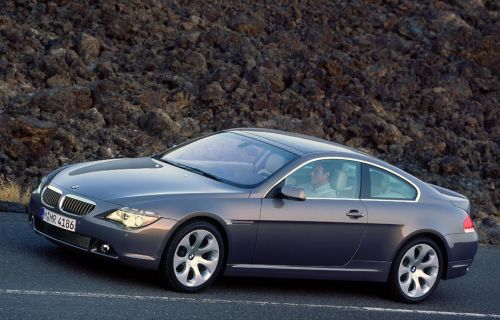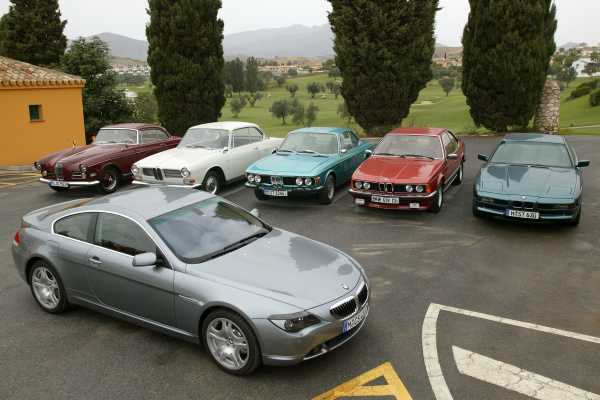
Innovation in Automobile Production always start with a vision...
Therefore Engineers & Stylists must not only have technical now-how but also a lot of imagination. They must be able to think along new unprecedent alliance and they must be bold enough to build what nobody has done before. To create genuine progress and be ahead of the competition, they must build bridges into the future. The E31 we present you on 8er.org represents a quantumleap in progress. It is the perfect bend of beautiful styling with fine performance & fascinating technology.

The designers retained the identifying BMW double-kidney grille, but shrunk it into a very low, all-plastic 3.5-mph nose. It was available in Chrome as OEM on the latest 840Ci ///M edition in Japan. Two large flaps hid the retractable headlights that incorportaed high & low beams and fog lights. If the main lights were retracted, slower traffic could be flashed with auxiliary lights at the far corners of the bumper (and trust it happens all time long). Although the shape is clearly a wedge, the stylists wanted to avoid making the trunk look high.
The relatively low luggage compartment lod gives the body the elegance character of a notchback instead of the "rucksack design" effect so often produced by cars with too much emphasis on aerodynamics.

When the 850i made its debut at the Frankfurt Auto Show in 1989 for the replacement of the much-beloved and long lived 6-series, it was felt like a car with contradictions. Although it was clear that BMW intended the 850i to be a mobile status symbol, in a word THE flagship of BMW : the ultimate Gran Turismo 2+2 coupe.
The 8 series represented a technological tour de force, and its styling marked departure from previous bmw coupes, making it one of the most beautiful BMWs ever made.
Unlike its aerodynamically challenged predecessor, the 6-series, the 850i benefitted from a substantial amount of CAD engineering and wind-tunnel testing.
That brought the 850i's coefficient of drag down at a remarkable 0.29 compared to the 635csi's 0.39 cd.
That aredodinamic efficiency was also achieved while keeping the look of the car "clean" and free of visible aero add-ons.
Extensive work was done on air intake and extraction, to the front and rear aprons, body sills & underbody.
The brake-cooling air ducts, as well as the wheels, were designed to extract air tangentially outward.
The roof's lateral convexity and the transitions to the A- and C-pillars also helped the E31's drag coefficient and made the car one of the least sensitive to crosswinds in the BMW stable.
Along with aerodynamic improvment, the E31 also got a CAD / modal analysis-engineered body shell that was lighter (by eight pounds at 728bs), stringer, stiffer (by 30%) and safer than its predecessor.
The body was designed to deform in a collision so as to reduce head and chest loads by 40% in conjuction with the SGS seat-integrated front seat belts, with automatically adjusted for height depending on the fore and aft position of the seat.
The rear seats used belts that retracted out of the center, which reduced the chance of head contact with any hard interior parts in side impacts.
The passenger's survival cell was designed to offer maximum protection in impacts up to 60 km/h (35 mph), a 17% higher kintekic energy absorption than what the Feds requiered.
BMW engineers aslo strove to reduce the cost of repairing damage from low level impacts through the use of plastic front & rear bumpers,energy absorbing foam and impact-absorbing folding tubes front & rear.
As a consequence, the 850i also provided protection for pedestrains and bicyclists that might be struck by the vehicle via rounded, smooth body panles, an energy-absorbing hood, hidden windshield wipers and non protecting rain gutters.
The overal construction was also intended to safequard lighter and smaller vehicles in that greatear proportion than normal of an accident's kinetic energy would be absorbed by the E31 in a crash.
The E31 received a comfortable, modern interior-elegant and understated but a with a certain Teutonic austeriry.
The multi-adjustable memory setas were the interior's most striking feature, and their cowhides covered a clever multi-density foam that gave the excellent confort on long trips.
The dashboard's dials, buttons, switches and readouts would make a pliot feel right at homen while the center console was the first to get the multi-informational display that most BMWs now feature.
Steering wheel rake and reach were electrically adjustable, and the wheel rose its highest position each time the engine was switched off, returning to the drivers setting when the ignition was turned on.
the E31's complex dual-zone auto ai conditionning system even filtered out, via a synthetic filter mat and static electrical charge, particles to below 5 microns.
The filters traps pollen, spores, dust, haze, germs, asbestos, insecticides, dust, diesel soot, bacteria and up to 30% if viruses.
Again, this was pionnered on the 8 and is now see on almost all BMWS.
Noise suppression was also a priority, with special attention paid to window sealing.
The 850i's flush side window lower themselves 1.5 cm when the doors are oipened; upon closure, a complex resealing process takes place, involving multiple-element rubber seals that keep the windows from bowing out at speed.
The resulting noise reduction is commendable, and permits you to listen to sublime music that in lesser cars would be accompanied by creaks, groans and the whirring of eletrical motors.
Part of the credit for quiet must go to the V12 engine - by design a very smooth, low-vibration motor.
Bmw further stilled spund a rigidly mounted central two-piece propeller shaft, more substantial castings for the gearbox and flange and ultra-high quality gear teeth.
The Same purpose was served by hydraulically damped pivots for the front axle, elastic-mounted brake/fuel lines, a damped fuel pump and separate spring and shock absorber mouniting points with additional rubber underlays.
The Interior underfloor, meanwhile, was a single premolded foam-backed noise insuflating shell.
The engine air intakes and filters were placed behind the headlights and given integrated noise damping, while an enclosed air guide from the long nose to the radiator kept turbulence to a minimum.
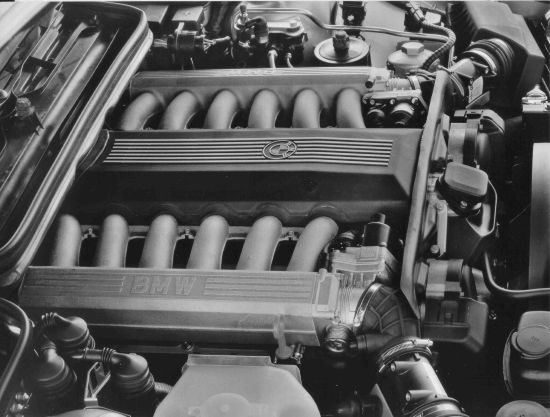
The engine itself was the familiar M710 5.0l V12 that had first appeared on the 750i, although it received minor changes for installation in the 8-series, such as relocation of the oil filter and rerouting of the throttle and fuel lines.
The 850's massive exhaust system was mostly stainless steel, with the outer cating of the mufflers made of aluminium-clad sheet steel.
The catalytic converters were integrated into the floor and featured outer contours shaped for low areodynamic darg.
After the cats, the exhaust gases entered a central muffler followed by two secondary silencers in the far rear corners of the car.
This expensive system was mounted directly to the body (rather than suspended by rubber rings) via preloaded solid silicon rubber mountings that could accomodate up to 1.4 inches of expansion.
Noise reduction, higher heat resistance, long life and automated installation on the assembly line were additional benefits.
The 5.0l aluminium block M70 v12 had fairly compact dimensions and a relatively low weight (528lbs). Eletrconic functions were handled by the state-of-art Bosch M1.7 digital motor electronics (DME) and an electronic power outpout control (EMC) that took care of the timing and fuel maps.
The M1.7 enabled the v12 to run as two six-cylinder engines; if one side had problems, the other could continue to run.
A single overhead camshaft per bank activated two valves per cylinder via self-adjusting hydraulic tappets.
Compression ratio was 8.8:1, while power outpout for the original 4,9998 cc v12 was 296hp at 5200 rpm and 332 lb-ft of torque at 4100rpm.
With the standard six-speed transmission, it propelled the 850i to a zero to 62mph (100km/h) time of 6.0 seconds.
As it is today, top speed in 1989 was electronically restricted to 155mph.
Most 850i's left the factory with the ZF four-speed HP 24 automatic transmission shared with the 750i-itself a nice electronically managed torque converter with Drive, Sport and Manual modes as well as a self-diagnostic functions, fault identification and an emergency operating program.
In 1993, this transmission was upgraded o the even more advanced and adaptable five-speed automatic Steptronic Gearbox.
Those who choose the manual got a six-speed aluminium pressure-cast transmission jointly developed by BMW and Getrag.
This remarkable transmission had a 1:1 fifth gear ratio, while sixth was a 0.831 overdrive. Bevel gear synchronization with sintered coatings on the synchronizer rings made for excellent longevity.
Automatic transmission fluid (ATF) was used for improved shift quality, especially at low temperatures.
Like the motor, the transmission mounts were hydraulically damped.
A single-plate 11-inch abestos-free clutch sent power to the final ratio of 2.65:1.
the 850i go a double pivot spring strut front suspension with aluminium lower wishbones that ensured very stable straight-line tracking and minimized brake dive.
Fornt track was increased by 4.8 inches overt the 6 series, and as in the 7 and the 5 series, the leading link was hydraulically damped to give even greater freedom from road noise and harshness.
Twin tube gas shocks and a stabilizer bar completed the picture of a faily conventional and competent front susepension setup.
The "integral" rear axle, on the other hand, was a very new & complex design specifically developed for the 850i.
This used "3D wheel location with optimized elastokinematics to prevent uncontrolled wheel angles & self-steering effects as a result of lateral, braking & tractive forces".
In other words, it tried to keep the car level and wheels aligned !
the steering was BMW's familiar Servotronic recirculating ball engne-speed sensitive power steering with a 15.4:1 ratio.
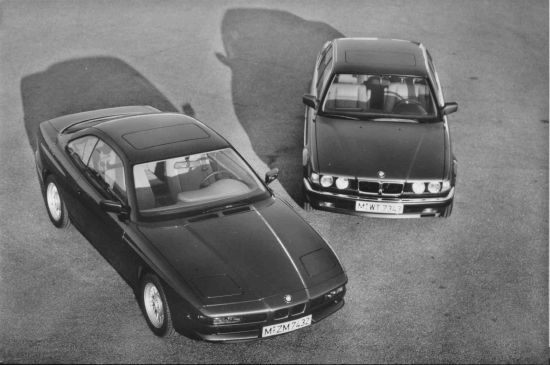
The E31 was more dependent upon electronics than any BMW that had come before it.
BMW was innovative in symplifying some very complex systems, being one of the first to make extensive use of multiplex systems (in which several electrical messages can be sent through the same wire) to reduce the size of the wiring harness.
In the E31, multiplex wiring was used for the instruments, central locking, windshiled wiper controls, windows and sunroof.
BMW also offered EDC III Electronic Damping Control on the 850i, a system of electronically controlled shocks that were adjusted according to sensor inputs that monitored road speed, passenger and luggage load, lateral, longitudinal, and vertical acceleration and steering wheel angle.
A trunk-mounted 16-bit microprocessor wth a 12MHz clock rate sent commands to the shocks, where solenoids adjusted the damping force within 40 milliseconds.
A driver-activated program selected the range, while a Sport Program deleted the soft seeting (30% softer than standard suspension).
The system performed seamlessly, while a self-diagnostic program reduced service and permitted the car to remain drivable in the event of failure.
And of course, there was a four-channel anti-lock braking system (ABS) consisting of 12.8x1.2-inch vented rotors clamped by single-piston floating calipers in teh front, and by parking brake-integrated 12.8x05-inch solid discs in the rear.
Pad wear detectors monitored the asbestos-free brakepads at the right front and left rear and sent a warning to the Multifunction Display on the center console when replacement time arrived.
The E31 also got ASC+T traction control and RDC tire pressure monitoring, two features which have become standard on most BMWs with time.
The 8 Series continued to evolve, by 1993, a v8-powered 840Ci had beend added to the lineup, while the 850i was replaced by the 850Ci with a larger 5.4l v12.
The manual transmission was eliminated on the 850Ci and BMW's second generation traction control system added, along with DSC II, which worked with ABS to control wheelspin at any of the car's four wheels, correcting oversteer or understeer as well as wheelspin under acceleration.
United States :
The BMW 8-series (internal platform code E31) began production in May of 1989 and remained in production for the U.S. market until August of 1997.
Worldwide production continued until August of 1999.
A total of 30,609 E31s were built, of which 6,788 were imported into the United States with the remainder sold in Europe and worldwide.
This discussion will focus on the E31 variants imported into the United States during the 1991 through 1997 model years.
Data from the BMW archives indicates that E31 production began in October of 1989, with the 850i. BMW claims that 649 examples of the 850i were sold in the United States during the 1990 model year.
In 1991, U.S. imports of the E31 peaked when BMW sold 1712 examples of the 850i in the United States.
In 1992, sales fell by more than half to 805.
In 1993, the 850Ci was introduced and 976 examples were sold in the United States. As described more fully below, except for some cosmetic items the 1993 850Ci was identical to the 850i.
So during model years 1990 to 1993, the initial E31 variant (badged as both the 850i and the 850Ci) sold a total of 4,142 cars in the United States.
Put another way, 61 percent of all E31s imported into the United States were imported during the 1990-1993 time frame.
Accordingly, if you are looking to purchase a used E31 in the US, the 1991 and 1992 850i dominates the market with the 1993 850Ci close behind. And it's fair to say E31s from all three years are virtually identical.
In August of 1994, BMW began producing an upgraded version of the 850Ci.
This model remained in production until BMW stopped building E31s for the U.S. market in August of 1997.
By that time MSRP had climbed to the $100,000 range, so it's not surprising that only 363 examples of the upgraded 850Ci were imported during the 1994 through 1997 model years
Put another way, for the V-12 cars the "first" E31 variant outnumbers the "final" E31 variant.
For those who know most of the history of the 8 series, here is something more interesting :
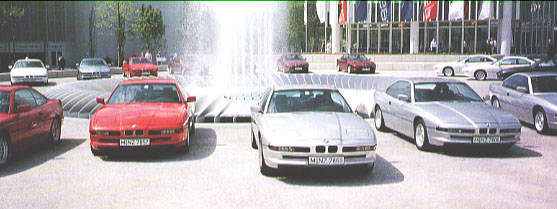
Cruising With the 8s Roundel, August 1991 Story & Photos by Bob Roemer
I have a model of a bright-red BMW 85OCSi in my office. I painted the area between its roof joints and the cowl glossy black, as BMW Individual did to distinguish many of the coupes. Every time I look at it, I'm reminded of what a curious page of BMW history this car wrote. I was so ready to fall in love with the new 850i, as it was called at the time of its introduction in Munich in 1990. After all, a new V12-powered BMW coupe, at least on paper, was quite a mouth-watering proposition. But just a few miles into my first drive, all sorts of mental alarm bells started going off. The super coupe just didn't feel like a BMW. I had the same reaction to it as I did to the Porsche 928. "Boulevard cruiser," I muttered under my breath.
"I heard that," said my co-driver, former Road & Track editor Ron Wakefield.
The 8 never really caught on. Conceived in the go-go `80s, when conspicuous consumption was politically correct, it saw the stock market collapse just prior to its introduction, drastically changing consumer values. Viewed from another perspective, BMW had the same bad timing with the 8 as Mercedes-Benz did with its just-replaced S-Class sedan; they were both too big and had too much fat-cat image for the `90s.
The 8 was to be a highly desirable status symbol: the ultimate elegant luxury performance coupe and a technological and aesthetic statement of BMW's leadership. None other than R&D chief Wolfgang Reitzle was its champion. The reality fell somewhat short of that aspiration, but that didn't diminish its enormous performance capabilities.
Our flight of two dozen 850s launched out of Munich on a gorgeous May morning, headed northeast to the charming town of Pegnitz and the equally charming Pflaums Posthotel. Every year this village is overrun by music lovers who make the pilgrimage to nearby Bayreuth for its famous Wagner Festival; the town is also adjacent to the Seventh Army Training Center at Grafenwohr, not far from field artillery firing points. The constant rumble of the 155mm guns prompted one unsuspecting journalist during an after-dinner stroll on a perfectly clear day to conclude, "I guess we're in for a thunderstorm."
Once on the (practically empty) Autobahn that ran right by the 850's birthplace factory in Dingolfing, we thought that in the interests of good journalism we should see how the then-relatively-new top-speed limiter functioned. BMW had recently entered into a gentleman's agreement with Mercedes-Benz and Audi to limit the top speeds of all cars to 156 mph; the fear was that a top-speed war among the car builders would be the excuse the anti-car socialists in the German government would need to slap a speed limit on the Autobahn.
The 850 was nothing if not silky smooth. It reached its terminal velocity in no time -- and cruising at One-Five-Six, to be honest, was no big deal. Try to push beyond that number and a combination of fuel flow and ignition timing conspired to bleed off any further progress -- without, as you would expect from BMW, lots of fanfare. It was a subtle message that, unfortunately, that's all there is.
Then it happened. A few kilometers up ahead, a big double-trailer truck-the Germans call them "road trains"-was lumbering along in the right lane. I'll never forget it; it was a bright yellow rig from the Wurth transportation company. Behind the truck, a lime-green Opel Record, moving about three kilometers faster than the road train, pulled out to pass. If you're following this, you realize the Opel pulled into our lane -- the Warp Speed lane.
They used to have this kind of problem at Le Mans, where a Ferrari, for example, would close on an Austin-Healey Sprite on the Mulsanne Straight at double the bug-eye's speed. Normally, it would be the overtaking car that would be catapulted into the forest along the famous stretch of road. That, I'll admit, was a historical factoid afterthought to what was going through my mind then.
What was going through my mind at the moment was how to avoid planting a kidney grille squarely in the rump of an Opel. That must have been the same thought on Ron Wakefield's mind; the barely audible gasp to my right let me know he had sized up the situation the same way I did. "I've got it" was about all I could muster in terms of an acknowledgment. In an instant, I was on the brakes.
The big coupe slowed dramatically, I thought. But when you're hauling down from 156 mph, 90 seems like you could open the door and get out of the car. Unfortunately, it was still much too fast-and now we were truly closing on the Opel at a frightening rate. Both of my arms were stiff against the steering wheel as I got back on the brakes in earnest. The brake pedal started its ABS judder. "Is that all we have?" I thought.
We were close enough now to see that the occupants of the Opel were an elderly couple -- and the driver was looking in the rear-view mirror with very wide eyes. Just when I thought about using the guardrail to shave off more speed, as they used to teach at the Nurburgring driving school, the 850 reached equilibrium with the Opel.
Now safely past the road train, the Opel driver pulled back into the right lane. Creeping by the truck, I noticed the driver staring in open-mouthed disbelief. Alongside the Opel, Ron and I waved meekly. Grandpa and Grandma waved back. It's amazing how quiet the cockpit of an 850i can be. A couple of kilometers down the road, Ron was the first to speak. "Pretty good brakes, huh?"
A few years later, I had an opportunity to drive another 850. This time it was an 850CSi, a coupe that had been massaged by BMW Motorsport; it was, for all intents and purposes, an M8. An enlarged V12 (5.6-liter as opposed to a five-liter at the time) with other Motorsport tweaks provided a whopping 372 horsepower compared to 296 in the standard coupe. There were also the appropriate suspension and wheel/tire modifications to complete the package. I picked up the car at the Cologne/Bonn airport, heading for the Nurburgring.
BMW had thoughtfully provided a map with a suggested autobahn route. But being familiar with the countryside and having previously experienced an 850 on the Autobahn (ahem), I thought it would be more fun to take the back roads.
This time, within the first few kilometers, I said out loud, "This is more like it!" The car was completely transformed from a cruiser to a responsive, energetic thoroughbred. It even had a little exhaust burble -- what's the sense of having a V12 engine if you can't hear it? Frankly, the metamorphosis was nothing short of amazing. It was absolutely a blast to drive. When I stopped for lunch in the little town of Honnigen -- where my father's ancestors lived before coming to the United States -- two gentlemen nodded approvingly at the car. "That's the new CSi, isn't it?" one of them commented. "That's much better than the original," his colleague added. They asked to see the engine and gave the coupe a thorough inspection.
Arriving at the Nurbuhhrgnhng's Dorint Sprint Hotel later that afternoon, I was greeted by a BMW executive. As I opened the door-and before I could say a word, he offered, "That's what it should have been in the first place, right?"
"Can I quote you?" I asked, still beaming from my drive.
"In about five years," he said, laughing. It has been a little more than five years, so the embargo is lifted. But I still shouldn't reveal my source.
Wolfgang Reitzle, by the way, had a custom 850 built by Individual with an interior he designed; it was powered by a supercharged V12 engineered by none other than BMW Motorsport's engine maestro Paul Rosche. With a wide grin, Reitzle confessed to this reporter that the car was, "really very, very fast." But, according to folklore, once, after a meeting, BMW's Number-Two Boss showed off the car to some curious industry colleagues. He closed the hood, slipped behind the wheel -- and it refused to start.
There was another Motorsport effort centered around an 8 coupe; This was a radical, lightweight monster with a four-cam V12 engine and a Spartan interior sporting lots of carbon fiber and a pair of serious racing seats. It was nothing less than a Bavarian Ferrari F40. The board didn't approve its production (come on, guys, where's your sense of humor?) and the prototype was relegated to M's candy-store garage on Pruessenstrasse, just north of the Four Cylinder Building.
Although the 8 never sold in the numbers BMW had hoped, it appealed to a seriously well-heeled audience. Many European customers specified modifications or special equipment installed by BMW Individual. One such customer ordered an 850 with several special items, including a custom leather interior. His dealer arranged a delivery date at BMW Motorsport and the gentleman went on with his global business travels, the happy date marked on his calendar.
On the appointed day he appeared at M, without any prior coordination, only to learn that his car was not ready due to a delay caused by an outside supplier. He was livid, and returned the following day with his attorney, demanding a meeting with BMW M's Managing Director, Karl-Heinz Kalbfell.
"He and his lawyer sat down at a conference table in my office and we began our discussion," related Kalbfell. "I had a beautiful book about Individual sitting on the table. While the lawyer was talking about how upset his client was over the delay, the customer picked up the book and started paging through it."
At one point he interrupted his lawyer. Pointing to some special wheels in the book, he asked, "Can I have these on my car?"
Kalbfell answered that it was possible and the customer asked to have them added to his order. "The lawyer just shook his head," Kalbfell laughed.
This time, the car was delivered on time.
In 2003, BMW finally decided to make a "successor" of the E31
It's called E63 aka the new 6 series
Though the BMW 840s & 850s remain the highest numbers of the BMW production....
Here is a shot of the new design :
